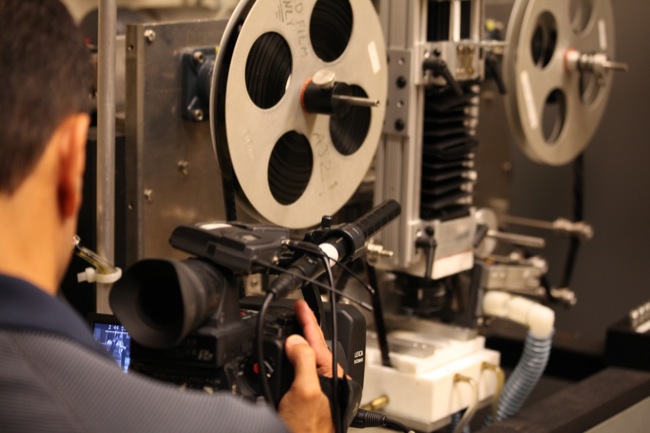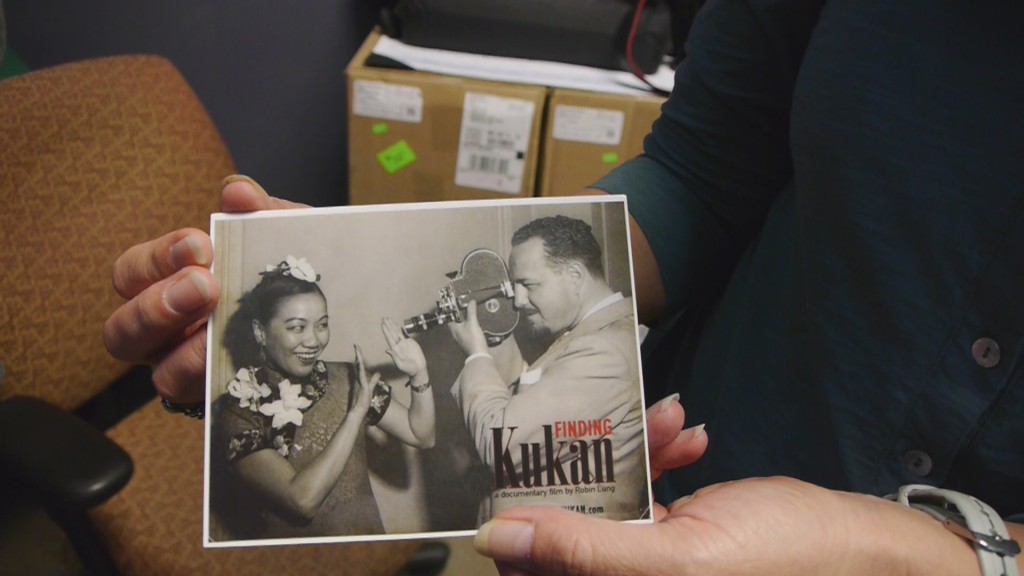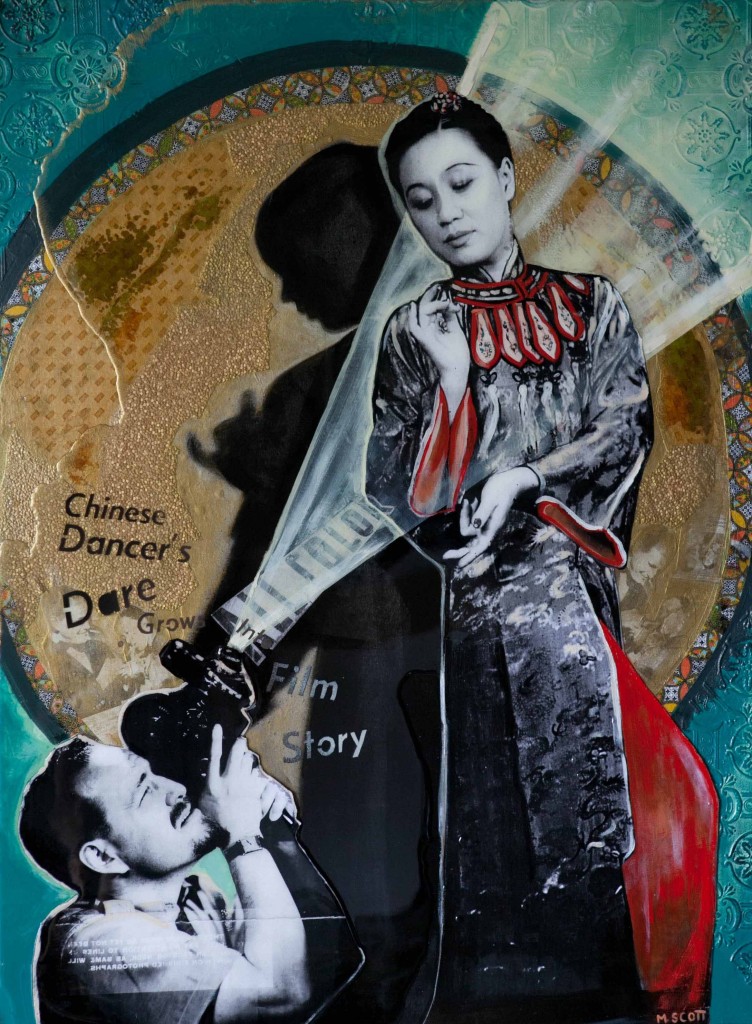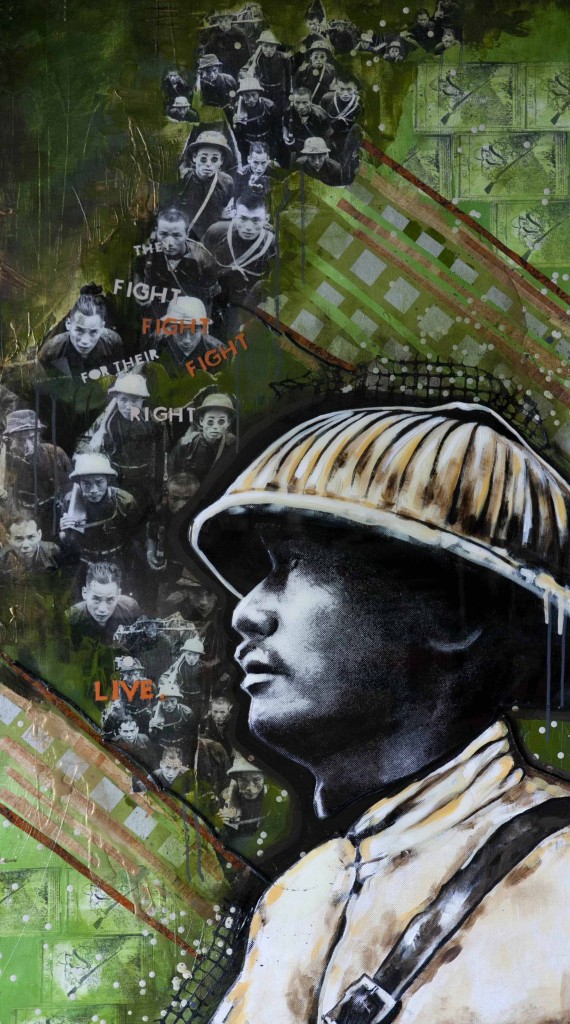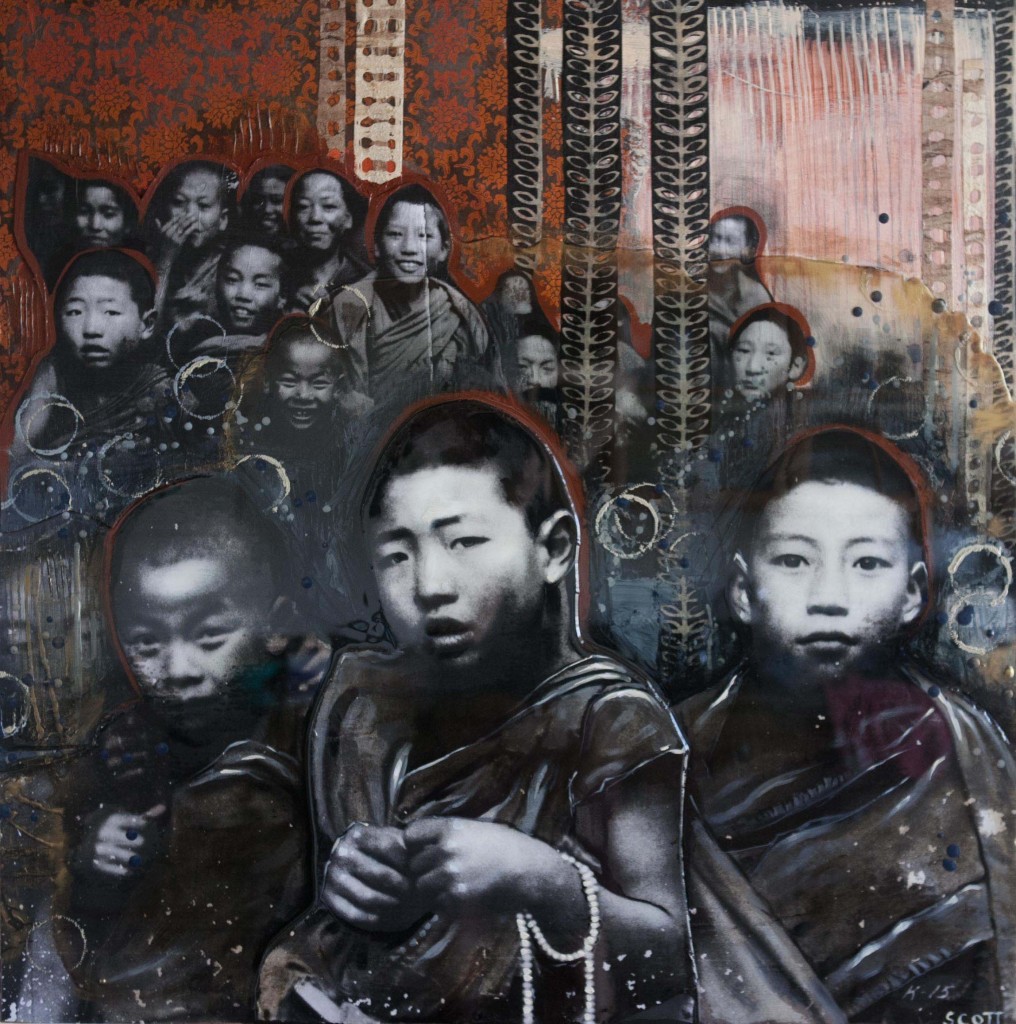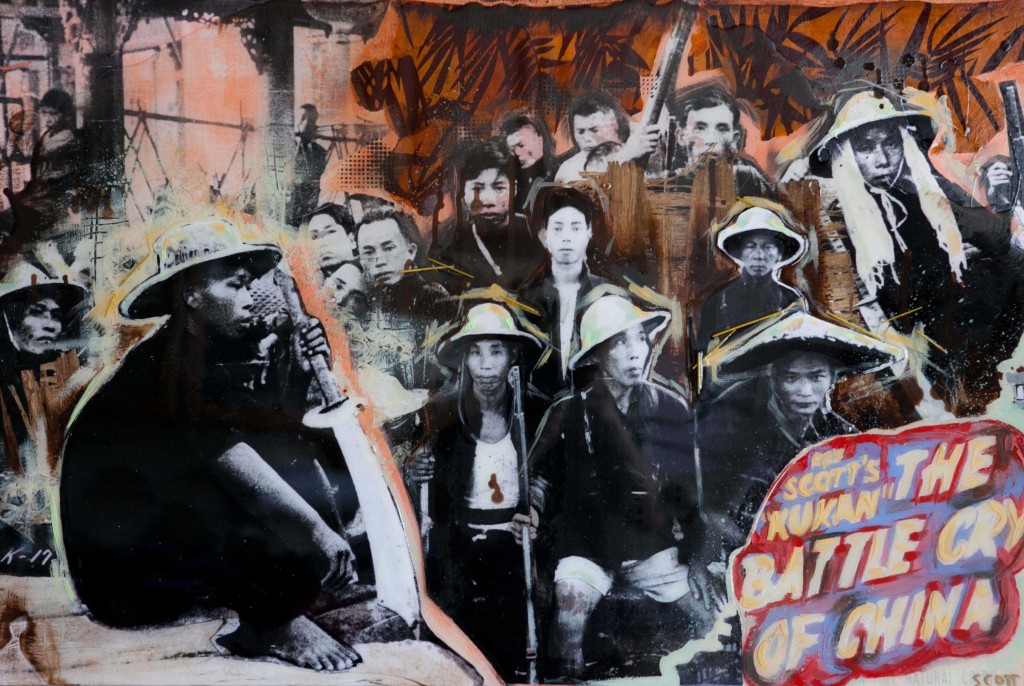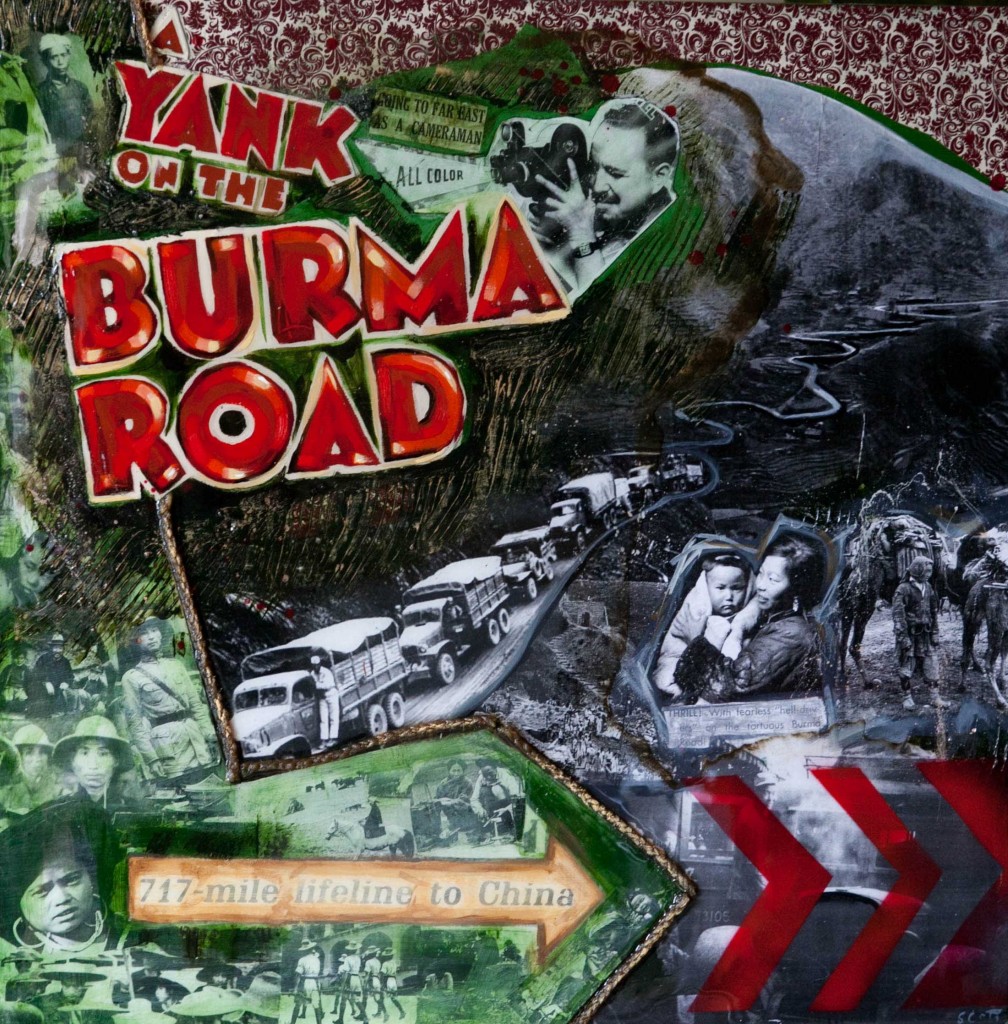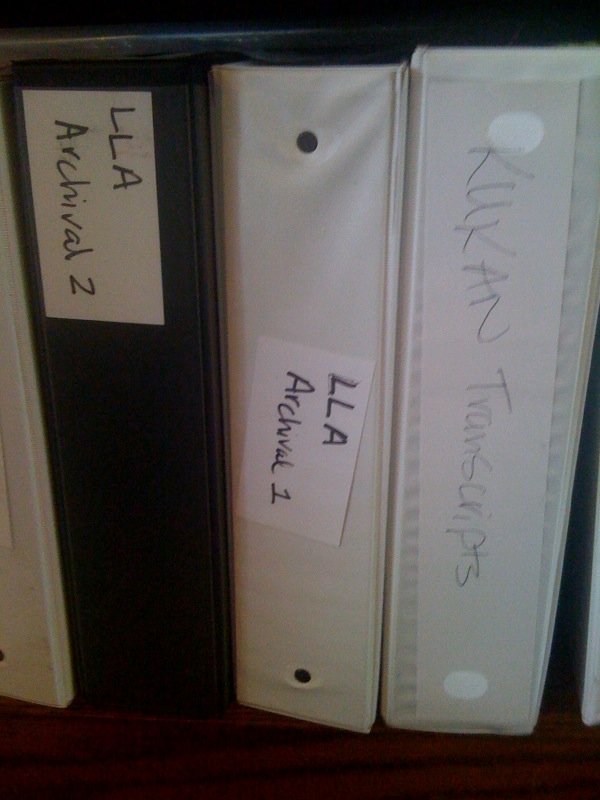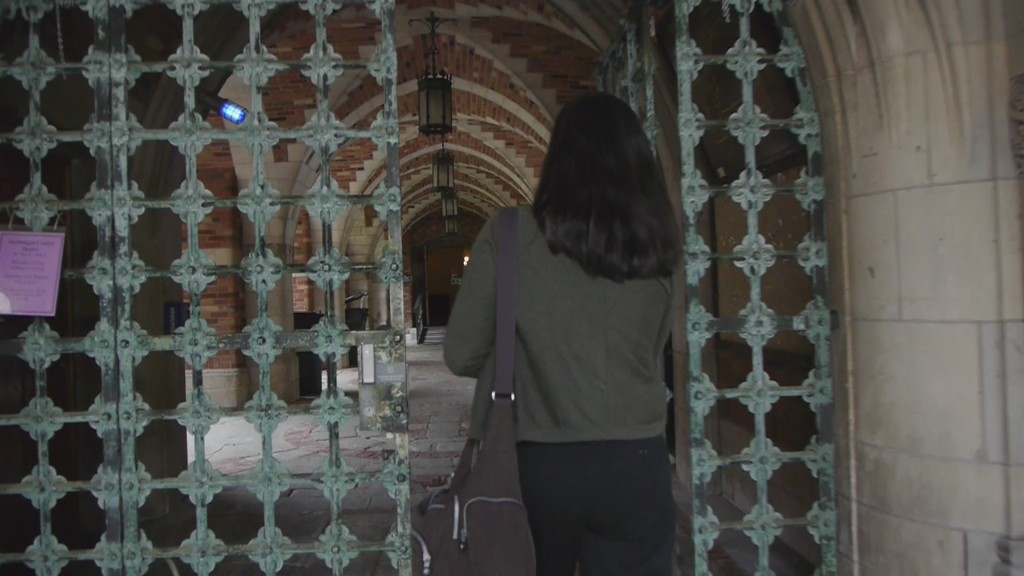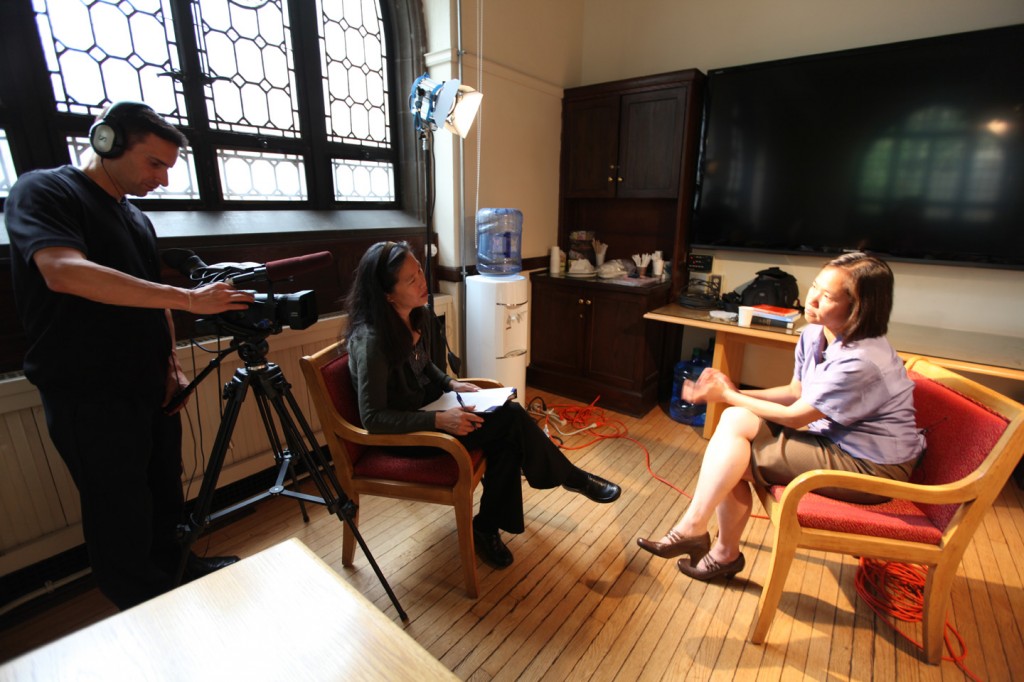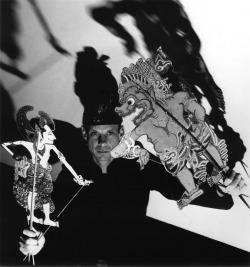Upcoming Screenings:
no event
Follow us on Facebook
HELP BRING FINDING KUKAN TO CLASSROOMS
Sign up for our mailing list.
Category Archives: Production
November 29, 2014 — Year in Review (Part 2 — New York in June)
New York in June could only be made possible by the hospitality of longtime friend Peer Just. A free place to stay in New York meant that I could funnel some of our funds towards filming two crucial interviews with Asian American scholar Judy Wu and the award-winning author Danke Li. Both provided important insights into Li Ling-Ai’s motivations and how World War II transformed the everyday lives of women in both the United States and China. Answering the last-minute call for camera help were our New York go-to DP Frank Ayala and another longtime friend Ruth Bonomo.
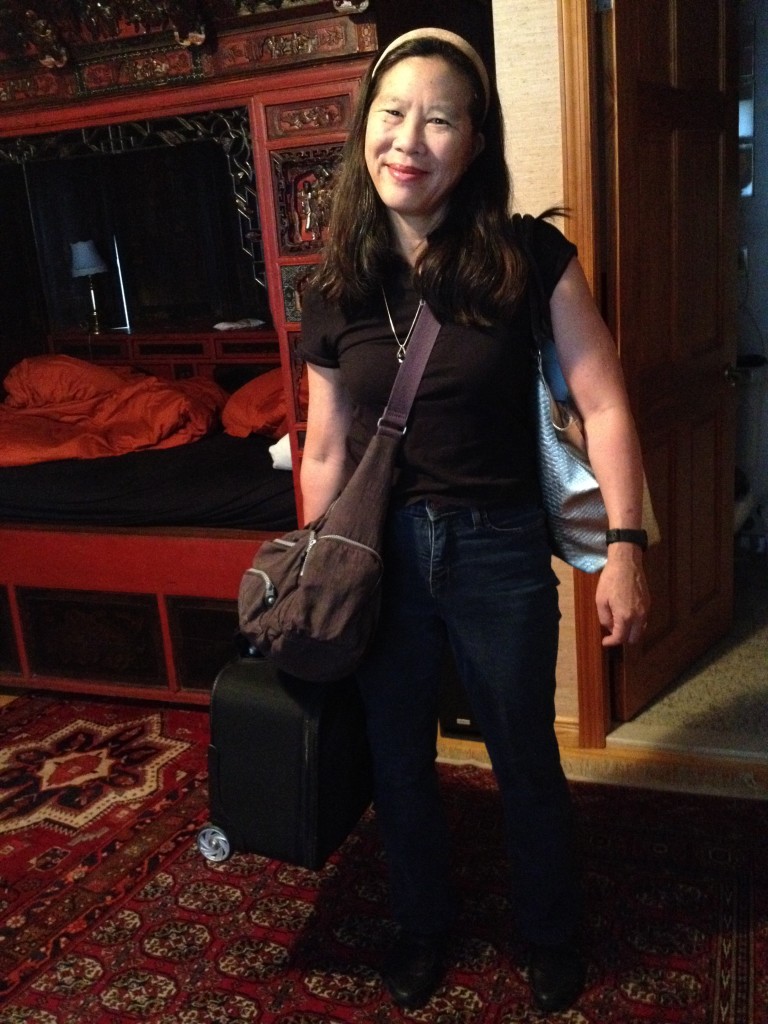
Leaving NYC home base for a day of production on Long Island — first the subway, then the train, then the ferry.

Judy Wu, author of DR. MOM CHUNG, took time out from her Port Jefferson vacation to sit for a great interview. Ruth Bonomo pitched in as DP on short notice, providing wheels, camera and lights. Judy’s family fed us a great spaghetti dinner beachside. Signing K for KUKAN!
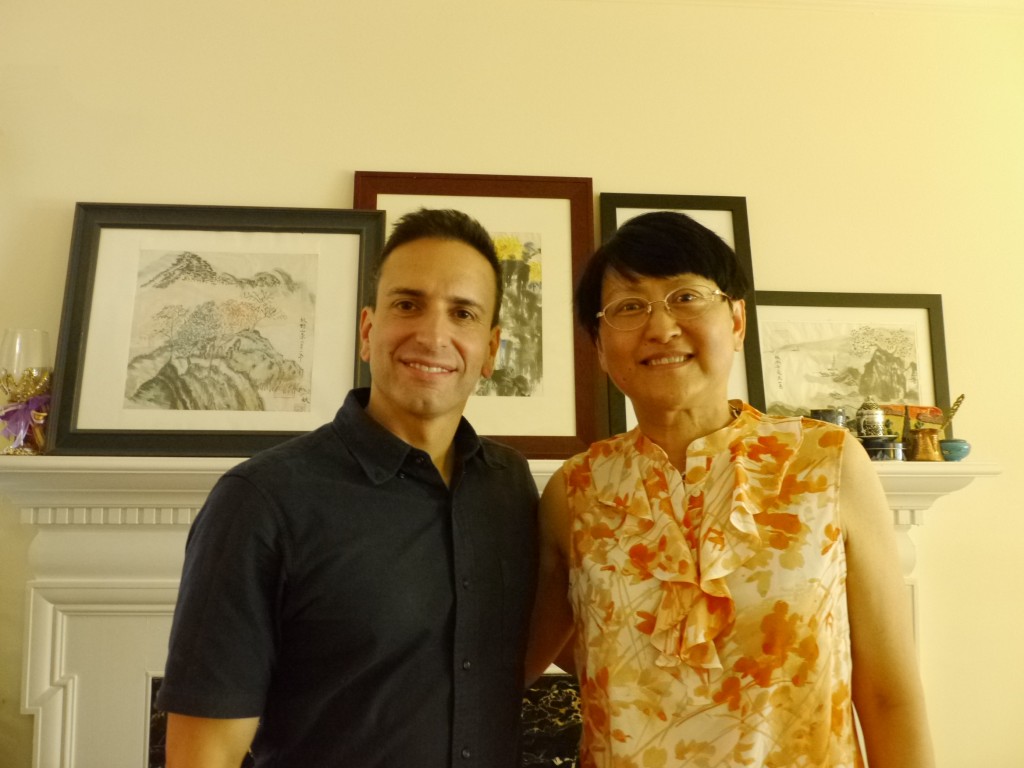
DP Frank Ayala with Danke Li, author of ECHOES OF CHONGQING, WOMEN IN WARTIME CHINA
A visit to New York also meant I got to hang out with Calamity Chang, who has volunteered to record temporary voice over lines that allow us to edit our historical scenes. Calamity constantly inspires me by her willingness to embrace her performance instincts and bare it all in her wonderfully tongue-in-cheek burlesque shows. She also knows her Chinese history and promotes projects like ours that bring it to the forefront. Her musician/photographer husband Mike Webb put in hours of free time as our sound man while dog Chewie quietly put up with our intrusion. After a super long recording session on a sunny Sunday afternoon, we all needed a New York specialty cocktail.

Going over scripts with Calamity Chang.

Musician and Photographer Mike Webb pitches in as sound man to record our temporary voice over tracks.

Chewie after a long recording session

One of the killer cocktails I had in NYC featuring cucumber and gin
Just being in NYC is a real shot in the arm for a filmmaker. Visual stimulation is everywhere and so are other artists whose very existence and work are like cheers from the sidelines.

Inspiration from Steven Salmieri and his wife Sydney Michelle

Inspiration from artist, hat designer and jewelry maker Carol Markel

Inspiration from my husband Paul Levitt who is designing a book with Dana Martin about his visit with Man Ray

More inspiration from a screening and Q&A with D.A. Pennebaker and Chris Hegedus
Before my New York trip I got word that I received a fellowship to go to China to join a group of high school educators form Canada and New Jersey on a World War II centered study tour. It would be my first trip there, so China was on my mind.

Looking ahead to China in July at the Ai Wei Wei exhibit in Brooklyn

Imagining China

China Kitsch
Li Ling-Ai’s spirit is also close at hand when I am in NYC. Her great friend Larry Wilson offered to point out the third floor apartment where she spent most of her life on West 55th street. The breeze picked up and the trees outside the apartment did a dance as we looked up to the third floor.

May 2, 2013 — Collaborating With Shadow Creatives
I knew when I saw the stunning shadow visuals designer/animator Chris Do did for a GAP campaign that I wanted to use the same technique for FINDING KUKAN. I envisioned Do’s animation being brought to the genius shadow scenes that Larry Reed develops for ShadowLight Productions as the perfect way of carrying the emotion of especially intimate or harrowing scenes in the dramatic narrative of Li Ling-Ai and Rey Scott’s lives.
So it was thrilling to have both Chris Do and Larry Reed in the same room with me today in Santa Monica at Chris Do’s BLIND design studio office space. Larry joined us by SKYPE and conference call from San Francisco (SKYPE can drop out on you when bandwidth is scarce).

Chris Do and Robin Lung SKYPE Larry Reed from the BLIND offices in Santa Monica
After our meeting I realized that I had found two creative geniuses who were also practical producers with years of experience in how to ACTUALIZE a visual idea. The pragmatic, step-by-step path to bringing a new way of visual storytelling to the screen in FINDING KUKAN, just got a whole lot clearer thanks to Larry & Chris.

Chris Do helps Robin Lung lay out a plan of action for creating FINDING KUKAN’s shadow scenes.
I invite you to check out their work HERE and HERE. If you are as wowed by it as I was, please consider contributing to the collaboration process at our Post-Production GIFT REGISTRY. If you have any cool shadow ideas or images you think would work well in the film, please post on our Facebook page at http://www.facebook.com/kukandocumentary and write “Shadow Idea” in the comments section (and don’t forget to LIKE us while you’re at it)!
December 13, 2012 — Seeing The Light
Today having just arrived home after a long trip, I decided to take a break from doing the laundry and catching up on emails to open up a box from Grendel Books on 18 Ireland Street — even the address sounded magical. I found a beautifully wrapped little book, padded in bubble wrap and tissue paper as if it was a precious object. It was a small little paperback that fellow filmmaker Stephanie Castillo recommended I read and that I had ordered before my trip.
Some passages in the first few pages felt as though the author were talking directly to me — addressing my fear of never catching up with things, my guilt at laying aside bill paying to discover a little gift. I’m sure the whole book is full of wise little gems and I will refer to it often. Here are a couple:
” If you are too choosey about the spaces you visit, you may miss Inspiration Point.”
“Every film is a voyage into the unknown. You set out for great India and arrive at a very small island in the Caribbean.…I have never begun a film, however well prepared, that did not prove to have a life of its own and lead me to a region where I did not expect to go. What safaris! What narrow escapes! The maps can lead directly to quicksands and the jaws of dragons. Yet sometimes the end of the trail may be quite near King Solomon’s mine.”
Thanks to Stephanie Castillo (veteran Kauai filmmaker) for recommending I read this. It comes at a time when I feel a little buffeted by the winds and, having just given up my part-time job, facing a future full of unknowns. It’s heartening to know that it’s part of a process every filmmaker faces.
October 8, 2012 — KUKAN Moves from the ER to the Operating Table
Many of you know by now that my documentary FINDING KUKAN revolves around my discovery of the “lost” 1941 Oscar-winning color film of war-torn China called KUKAN. Many of you might also be wondering, where in the H… is KUKAN? If it was found, then why can’t we see it? Well when I tracked down the only full copy of the film it had been sitting in a Fort Lauderdale studio for a few decades and then a Georgia basement for a couple more. Heat and humidity had done its work.
When AMPAS’s Ed Carter and Joe Lindner opened the rusty metal can that contained KUKAN they winced. “Vinegar,” they both said, wrinkling their noses. I learned later that that is a sure sign of deterioration. As Joe examined the 2 reels of film that represented 90-minutes of invaluable color footage of China in 1939 and 1940, he detected both shrinkage and brittleness (more bad signs of deterioration). Joe said he’d seen films worse off…but not many. Things looked pretty grim. If we were in the Emergency Room, this would be time for triage.
Fortunately a deteriorating film takes longer to die than a bleeding human. Two years later, KUKAN has been stabilized but is still in pretty bad shape as you can see by the photos I took of it last week at Colorlab in Maryland where AMPAS sent it to have major restoration work done.
Parts of it are so curled that they will never be able to be re-plasticized (a sort of Botox process for film that hydrates it enough to allow it to lay flat in the scanner without breaking).

The worst part of the 2 KUKAN reels was so curled it looked like the plastic straws you drink out of.
A partial copy of KUKAN that I located in the National Archives (NARA) will be used to fill in those parts that are unsalvageable. The NARA copy was kept in a temperature controlled environment all these years and is in fairly good shape. But even that has to go through a frame by frame scanning process to pull both image and soundtrack from the 16mm strip.
DP Frank Ayala, 2nd Camera Mia Fernandez and I arrived at Colorlab to film the initial frame by frame scanning of the NARA print and learned a lot about the care and effort needed to bring a film back to life.
A.J. Rohner, head “surgeon” on the KUKAN restoration process, assured me that “my patient” could be saved despite its horrific appearance. He gave us a tour of the monster machine that does the scanning – an invention of Colorlab engineer Tommy Aschenbach.

The scanner doing all the work is a fascinating contraption that blinks and whirs and beeps — just like something out of Startrek.
I was entranced by its gorgeous parts, blinking lights and robotic movements — so much more tangibly satisfying to see at work than watching the little gray line creep across your computer screen as your digital footage downloads.
I also learned how the sound from the film will be lifted from the scan, VISUALLY corrected before turning into sound waves and then cleaned and scrubbed to get all the ticks, and hisses out. I was surprised to learn that those little horizontal lines on the edge of the film are what make the sound come alive through the projector – a magical phenomenon when you think about it.

If you look carefully you can see the sound stripes on one edge of the film. The top strip is the badly deteriorated copy of KUKAN I found. Notice the color loss.
From the photo below A.J. identified the camera Rey Scott was using in China as a 16mm Bolex.
Colorlab technician Laura Major just happened to have one in the office that she still shoots with.
Holding that camera in my hands, looking through the tiny viewfinder, and learning that the camera could only shoot 100 ft of film at a time (roughly 2 minutes) gave me a much greater appreciation for Rey Scott’s heroic accomplishment in filming the epic scenes contained in KUKAN, especially the 15-minute sequence at the end of the movie that depicts the massive bombing of Chungking and the fiery destruction of the city.

You can’t believe how tiny everything looks through this viewfinder — no wonder Rey had a hard time focusing in places.
I am more determined than ever to reach our $16,000 Kickstarter goal so that we can keep following the magical resuscitation of KUKAN and track the amazing story behind its creation. Please join me on this journey, it’s going to be an incredible ride!
October 3, 2012 — Michelle Scott Delivers a Knock Out with her KUKAN SERIES
When I first made contact with Rey Scott’s granddaughter Michelle Scott and filled her in a little about the story behind KUKAN, she felt a need to transfer that story into paint and shared with me a vision she had for creating a whole room of paintings dedicated to her grandfather and KUKAN. It seemed like a far-fetched dream back then. So I was more than a little excited to go to Atlanta to witness the opening of Michelle’s solo show — THE KUKAN SERIES. Michelle hadn’t shared any images of the new work with me, so I wasn’t prepared for the visual sweep and emotional power of the work. It literally brought me to tears. Here are a few choice pieces from the show. WARNING — these photos do not do the pieces justice. The real pieces have an almost three-dimensional quality that allows the viewer to enter into the scene and experience a little of Rey Scott and Li Ling-Ai’s world back in the late 30’s.

Artist Michelle Scott with “Start of a Journey” the exclusive premium available for a $5,000 Kickstarter pledge (partially tax deductible).
The 36“X36” piece that Michelle created exclusively for our Kickstarter fundraising drive is displayed right in the front window of 2Rules Fine Art in Marietta. Casual strollers walking down the sidewalk can’t help but be pulled in to find out with the imagery is all about. For close up details of this painting go to our Kickstarter home page.
The KUKAN Series contains a few gorgeous tributes to Li Ling-Ai the Chinese American author who was the uncredited co-producer of KUKAN with Rey Scott.
The work below contains images of Li Ling-Ai from three different decades and three different locations (the old Honolulu Academy of Art, Beijing China, and New York City)
There are also fabulous pieces that provide a visual montage of the China witnessed through Rey Scott’s camera. He took both stills and 16mm color movies. Some of his old cameras are on display too with the original stills.
Rey Scott traveled all the way to Tibet and filmed some of the first color footage of prayer rituals there.
Michelle’s take on the original KUKAN lobby cards for the United Artists version of the film.
Rey Scott also filmed the famous Burma Road as it was being built.
A reminder of the British influence in Hong Kong which fell to the Japanese in 1941.
A whole movie could be made just about the baby giant panda bear that Rey Scott brought from Chengtu to the Chicago Zoo. Originally christened “Li Ling-Ai” by the foreing journalists in Chungking, it was later named Mei Lan when it was identified as a boy panda bear.

“Portrait of a Lady” and “For Him” are the first two pieces that Michelle Scott made in the KUKAN Series
There are many more gems in this show. But the emotional highlight for me was being able to see the first two portraits of Rey Scott and Li Ling-Ai that Michelle did. I first saw them on her website before we even knew each other and before she even knew who Ling-Ai was. This was the first time I was able to see them both in person. Since the pieces had been sold to different collectors several years ago, this was also the first time they were reunited in the same room for quite some time — a symbol of hope for me as I continue to seek funding to finish FINDING KUKAN.
If you are in the Atlanta area make an effort to see this historic show — up only until October 26, 2012
July 24, 2012 — An Earfull At the Ear Inn
As the weeks wear on and I get closer to the deadline for submitting a grant application to the NEA, I have periods of doubt and wonder if it’s even worth it to try for such a prestigious thing. And if I don’t get awarded a grant what will it mean – that the project is unworthy, and I should give up?
Glancing through pictures I took in May I’m reminded that getting grants and making Art are two different things. These black and white snaps were taken on a hot summer night when I joined my husband Paul and our friend Peer at one of NY’s oldest bars – The Ear Inn on Spring Street.
As I ate muscles at the bar and listened to old-time jazz, a woman named Katerina introduced herself. She had an intriguing accent and was very charming.
Several minutes later her friend Roland joined her – an artist, he showed her photos of his latest work on his Iphone.The striking shadows in his imagery prompted me to talk about the ideas for shadow play I had in mind for FINDING KUKAN.
For some great use of shadows, you should see THE THIRD MAN, said Roland. He sounded like he knew what he was talking about. When I got home I looked up Roland’s website – photos of his performance pieces made me think of all the possibilities before me. The doors to creation opened up a crack.
As I watched THE THIRD MAN for the first time the doors were thrown wide open. Every shot was a compositional gem and fired up ideas in my head for ways to visualize my own search.
I’m hanging on to the DVD so I can watch it for the third time – a reward I’m going to give myself after getting that grant app finished. You DO need a lot of money to make movies, but you DON’T need a lot to enjoy the heck out of them.
Thanks to Roland Gebhardt and the Ear Inn for reminding me of why I’m writing grants applications in the first place.
Whether it’s the bar, the gym, or the beach, we all need to leave the desk once in awhile to get a fresh perspective. Where do you go when you need a creative breath of fresh air?
July 7, 2012 — Getting Ripped Off
The police warn about it all the time, holidays seem to bring out the thieves in droves. Hawaii is no exception and I found out the hard way on July 3 when our house was burglarized in broad daylight. Bad news — all of my cameras and jewelry were stolen.
Good news. The computer and hard drives weren’t taken and the film and all my archival documents and years of research remain intact.
I am reminded of a Northern Exposure episode where Marilyn Whirlwind tells a story about a lucky situation turning unlucky and then lucky again. See transcript of story here.
I had a little mourning session for each item I listed in the Police Report, especially pieces of jewelry that my grandmother had given me. But as I was writing that up, friends from all over were responding to my Facebook post about the incident, offering help, comfort, loans of camera equipment, etc. Reading those posts I realized just how lucky I was.
But how to prevent future losses? Old fashioned safes might protect jewelry and cameras in the future, but what about those archival docs and film footage? Is cloud technology a practical solution? Anyone have experience using technology to safe guard precious photographs or documents? Let’s hear your story.
June 28, 2012 — A Visit to Yale and Chinese Exclusion
The recent FINDING KUKAN shoot at Yale University brought out the perpetual student in me. You can’t help but be awed by the vaulted ceilings and Knights of the Round Table atmosphere of the Hall of Graduate Studies where my interview with Yale Professor of American Studies Mary Lui took place.
The building reminds you how much history has come before you and how much you are ignorant of.
Fortunately the halls of learning at Yale are populated by people like Mary who dedicate their lives to gathering knowledge and disseminating it to people like me.
In trying to understand the social climate that prompted Li Ling-Ai and Rey Scott to risk money and life to make KUKAN, Mary Lui reminded me that the behavior of Chinese Americans like Li Ling-Ai was still governed in part by prejudicial immigration laws enacted against the Chinese — the most infamous one being the Chinese Exclusion Act passed in 1882.
Meant to keep cheap labor from entering the US, the exclusion laws ended up doing much more than that. From restricting the formation of Chinese families, to rendering the few Chinese women around at the time exotic creatures with questionable backgrounds the Exclusion Laws had negative repercussions on even the richest and most educated Chinese Americans. It’s no wonder that with so few Chinese Americans around that stereotypes and misconceptions about them would form.
I came back to Hawaii much better prepared to appreciate the historic bill recently passed by Congress to officially apologize for the prejudicial laws that targeted Chinese and other Asians in America for over 80 years.
One of the stereotypes I had about my own ethnic background was that Chinese don’t make waves and passively accept their fate, letting bygones be bygones.
The courageous efforts of people like Congresswoman Judy Chu and organizations like the 1882 Project belie that stereotype and bring a new validation to the history of Asians in America that will hopefully prompt more stories about an era of exclusion that we still don’t know enough about.
Are there ways that exclusion laws have affected your life? Let us hear from you.
May 5, 2012 — The Enchanting World of ShadowLight
I’ve always been entranced by shadows — the magical play of light on the walls in the morning and eerie shapes that your own body throws as you walk on the beach or sidewalk.
I wasn’t aware that there was a traditional form of shadow puppetry performed throughout Asia until I saw the Zhang Yimou movie TO LIVE in which one of the main characters is a shadow master (this is a great film BTW).

Traditional Chinese shadow play figures

Zhang Yimou’s TO LIVE
The shadow puppet scenes were so hypnotizing that when I was struggling with how to visualize epic historic scenes in FINDING KUKAN in an economical way, the idea of using shadow puppets came up for me. I started hunting on the web for people who performed shadow puppetry, and when I came across Larry Reed & Shadowlight Productions’ THE WILD PARTY, I was really blown away.
This was not the land of your grandmother’s shadow puppets anymore. Live actors, contemporary scenes, and shifting perspective lent a new dynamism to the production that I instinctively felt would be perfect for what I wanted to do in FINDING KUKAN.
Happily Larry was excited about my project and has agreed to collaborate with me on FINDING KUKAN. Larry Reed is truly a shadow master, having studied and performed traditional Balinese shadow puppetry for over 35 years. In the early 1990’s, Reed invented an ingenious shadow casting method, which integrates the traditional shadow theatre techniques, cinematic effects and modern theatre and dance styles. Watch for a sample of Shadowlight’s innovative work from THE GOOD-FOR-NOTHING LOVER in the new FINDING KUKAN teaser that will premiere next week.
Have ideas for cool ways of using shadows? Please let me hear from you.
January 30, 2012 — Georgia Remote Shoot
I got goose bumps when I first saw Michelle Scott’s paintings on her webpage two years ago, and I’ve been a fan of her work ever since. Since my discovery of KUKAN, Michelle has been using her grandfather Rey Scott’s China photographs in her paintings.

“Battle Cry” by Michelle Scott
Recently she created a couple of exciting new paintings for a group show at 2Rules Fine Art Gallery that will open on February 3rd in Marietta, Georgia. While seated at my desk in Hawaii, I was able to interview Michelle about that process with the help of Skype and Atlanta DP Wes Browning of Sema Films.

Director Robin Lung conducts Skype interview from Hawaii.
Wes also got some nice shots of Michelle putting some final touches on her paintings before delivering them to 2Rules. Wes and Skype facilitated another virtual meeting and interview with gallery owner Becky Rule. Of course I would have loved to do be there in person for it all, but I’m thankful that Skype and Wes allowed me to be a virtual part of it. Here are some photos Wes took of the shoot.


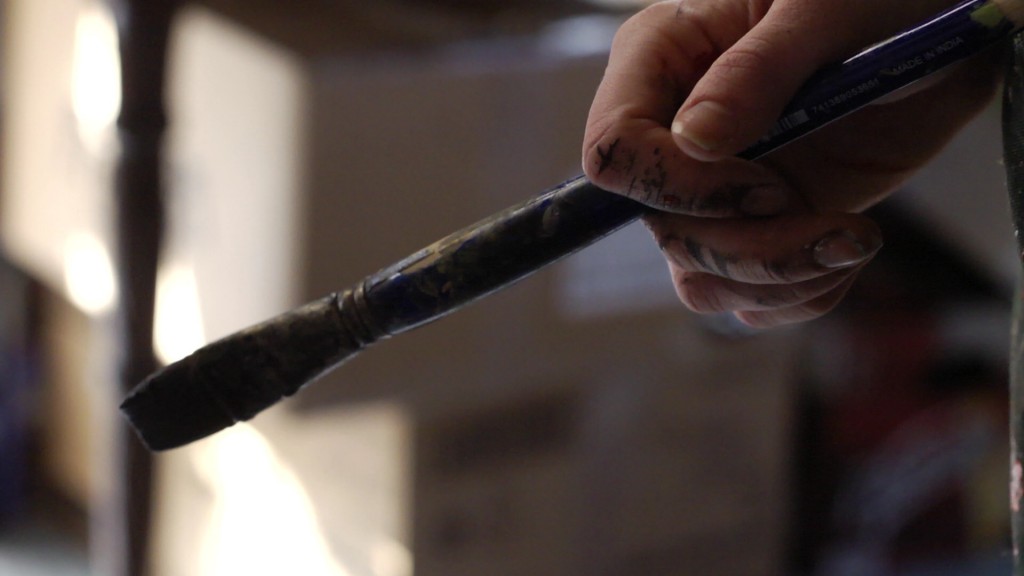




Becky Rule of 2Rules Fine Art





